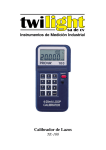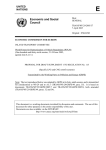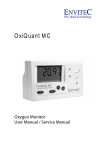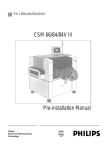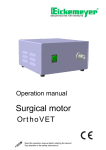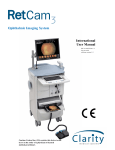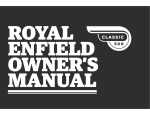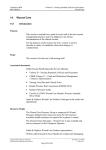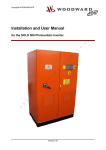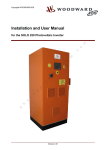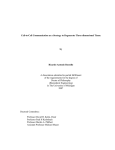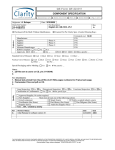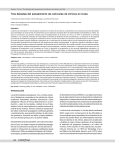Download User manual MEEK (English)
Transcript
MEEK Micrografting - Instructions for use and installation - Technical data Cylindrical motor and hand drive IFU MEEK 14-03 MEEK cutting machine MEEK prefolded gauzes 0344 General remark This manual describes how the MEEK technique is performed in text and pictures. For a better understanding of the procedure we strongly advise you to watch the MEEK instruction films that come on a DVD with each machine. These films clearly show the MEEK procedure, from assembly of the machine until healing of the burn wound. NOTE: The videos about the MEEK procedure, and handling of the equipment are also available from the Humeca website www.humeca.com (section ‘MEEK Micrograft’ submenu ‘videos’). You can also scan one of the codes below: MEEK instructions MEEK surgery Warning: Always pay attention to the presence of very sharp blades in the MEEK machine. Please handle them with care to prevent cutting accidents! 3 Contents SECTION I I. II. III. IV. V. INSTRUCTIONS FOR USE AND INSTALLATION Mounting and dismounting the machine 1. Assembly of the machine 1a. Placing the pneumatic motor 1b. Connecting the air hoses for pneumatic drive 1c. Placing the hand drive 2. Lubrication 3. Sterilization and cleaning 3a. Preparing before cleaning and sterilization 3b. Cleaning and sterilization procedure 4 4 5 5 5 6 6 7 The Micrograft-procedure 1. Determining the expansion factor 2. Harvesting the graft 3. Preparing the skin before cutting 4. Placing the cork with the graft into the cutting block 5. Cutting 5a The first cutting 5b The second cutting 6. Applying adhesive to the autograft 7. Transferring the graft to the gauze 8. Extending the gauze 9. Removing the fabric from the wound 10. Local therapy 11. Trouble shooting 10 10 11 11 12 12 12 13 13 14 14 15 16 Service Ordering Supplier Pictures SECTION II TECHNICAL DATA 20 21 22 23-35 36-47 4 SECTION I INSTRUCTIONS FOR USE AND INSTALLATION I. Mounting and dismounting the machine See fig. 1 and 2. The machine consists of a cutting block 1, a frame 2 and a pneumatic motor in a cylindrical casing 3, or a hand drive. Rotation of a hand wheel 4 causes the cutting block 1 to move under a bridge 12 where 13 circular blades cut through the skin. Attention: Never sterilize the motor !! 1. Assembly of the machine Check whether the blades axis 10 is in its right position, as shown in fig. 2: the bearings should be in their seats and the coupling 15 should point to the left side, when facing the hand wheel side of the machine. Place the bridge 12 (fig. 1) on the frame and fasten the bolts 11 by hand. 1a. Placing the pneumatic motor The procedure to be followed for placement of the motor on the machine is illustrated in fig. 3-9. Because the motor is not sterilized, it is encapsulated in a sterile cylindrical casing (fig. 3). A circulating nurse places the unsterile motor 22 into the sterile casing 3, that is held in position by authorized personnel. The motor is placed in the casing in such a way that the cam 22a comes in the groove of the casing, as shown in fig. 4 and 5. Now place the casing with the motor inside on the machine and push the coupling hull 15a of the motor over the coupling hub 15 of the blades axis (fig. 6). See to it that the casing 3 fits precisely in the groove 14 of the bridge. The hole 3a in the cylindrical wall of the casing should be at the upper side (fig. 7). Close the clamp 10. The cam 10a of the clamp should come into the 5 hole 3a of the casing wall (fig. 8). If clamp 10 cannot be closed, either the hole 3a is not in the right position, or the casing 3 is not pushed into the groove 14 of the bridge. After closing clamp 10, fasten motor bolt 9 (fig. 9; push and turn a quarter). The motor is taken off by acting the other way round. Attention: Beware that the motor doesn’t fall out of the casing! 1b. Connecting the air hoses for pneumatic drive The procedure is illustrated in fig. 10-14. The foot pedal has two connections (fig. 10). One air hose is already fastened to the pedal. Connect the other end of that hose to the motor inlet 22b by pushing the quick connector 8 over it (fig. 11 and 12). Because there is a large variety in hose diameters and connectors in use internationally, we cannot supply the air hose between the foot pedal and the pressure system in the operating room. Please arrange a suitable hose for that purpose yourself. We’re happy to assist you if necessary. It is also possible to use an air cylinder instead of the wall outlet. Connect the hose from your pressure system to the other connection of the pedal by means of quick connector 24; see fig. 13. This quick connector is fixed to the hose with a hose-clamp. Connector and hose-clamps of different sizes are supplied with the machine. See fig. 14 for instruction. A pressure of about 6 bar (87 psi) is advised. Do not exceed 8 bar (116 psi). The apparatus is now ready for use. 1c. Placing the hand drive The procedure for placing the hand drive is illustrated in fig. 15-17. Place the coupling hull 15a of the hand drive over the coupling hub 15 of the blades axis and place the white polymer disk 20 in the opened cylindrical support (fig. 15). The hole 20a in the disk should be at the upper side. When closing clamp 10, the cam 10a should come into the hole of the disk (fig. 16). Fasten bolt 9 (push and turn a quarter, fig. 17). 2. Lubrication To grease the bearings of the blades axis and spindle we recommend to put a drop of oil into the holes indicated with a red circle in fig. 19. Also put a drop of oil on the half nut at the underside 6 of the cutting block (fig. 18). In case of pneumatic drive, we also advise to put a drop of oil into the inlet of the motor once every 3 ® months. Humeca supplies Aesculap STERILIT oil for that purpose. 3. Sterilization and cleaning 3.1. Preparing before cleaning and sterilization Take out the motor. Beware that it doesn’t fall out of the casing! Attention: Never sterilize the motor !! The entire Micrograft cutting machine can be cleaned and steam sterilized, except for the motor. Autoclaving occurs at a common o o temperature of 134 C (usually 5-10 minutes) or 121 C (prolonged exposure time of approx. 20 minutes). If necessary, clean the blades by hand from tissue and body fluids immediately after use. To that end loose the two screws 11 (fig. 1) and lift off the cover 12 of the bridge. Take out the blades axis, clean it with water and a soft brush and replace it in the machine. Attention!!! Never touch the blades with your fingers! They are extremely sharp. Never touch the blades with some hard object nor place them on a hard surface. They’ll be damaged. Also the inside of the cutting block cover has to be cleaned by hand sometimes. Because this surface contacts the skin during cutting, on the long term a sticky layer (biofilm) might be formed. If persistent, this layer has to be removed mechanically by hand. Fig. 20and 20A show how the different parts of the MEEK machine can be placed in the MEEK sterilization case 3.MAC02. If you use a different case, please leave the blades axis in position on the machine during washing and sterilization (as shown in fig. 2) in order to prevent damage. Alternatively, you can put the blades axis separately in the small sterilization case 3.MAC03 (fig. 21) that Humeca supplies for this purpose. The cutting block 1 and the serrated wedge 17 are placed next to the machine during sterilization. 7 3.2 Cleaning and sterilization procedure Parts of Humeca surgical instruments are made out of anodised aluminium. This material is corrosion resistant to a large range of chemicals that are in use as cleaning and disinfection agents for surgical instruments. However, before cleaning and sterilizing the products, we ask you to pay attention to the following (please consult your Central Sterile Services Department (CSSD): The instructions for use of the cleaning agent should indicate whether or not the product is suitable for cleaning and disinfecting anodised aluminium. Please find out if this is the case and if necessary contact the supplier for this information. We recommend using neutral cleaning agents in combination with demineralised water. Strong alkaline cleaning agents (pH>10) cause clearly visible changes, such as marks and colour fading after only a few cleaning cycles. The intermediate acidic rinse used in an alkaline cleaning process also may attack the anodised aluminium surface. Don’t use H2O2 in the washing process. Do not use softened water in the rinsing and disinfection stages. After only a few cycles the anodised surface will show clear signs of detoriation. After intensive use you will see fading of the coloured parts of the instrument. This however is considered as a normal process and it doesn’t harm the instrument. 8 The following tables detail the cleaning, disinfecting and sterilization process. CLEANING Step 1 2 Description Removal of tissue and body fluids Pre-soak (optional) Pre-soak rinse 3 4 Drying Automated washer 5 Instruction Rinse with warm water and use soft brush Immerse device into water and liquid cleaner Rinse product under warm tap water and clean with soft brush Dry with wipe and/or air Place device and brush in washer Accessories Soft brush and tap water Duration Until all visible pollution is removed - Tap water - Neutral pH disinfectant/cleaner Minimum 15 minutes - Tap water - Neutral pH disinfectant/cleaner Minimum 30 seconds - Wipe - Dry air - Washer - Cleaning solution - Washer neutralizing solution (if applicable) Until product is visually dry. Minimum total cycle time 34 minutes when including all steps below AUTOMATIC WASHER CYCLE Step Minimum time 3 minutes 3 minutes Recommended temperature oC Pre-wash 65 Cleaning I 85 Cleaning II or 1 minute 20 neutralizing Rinse I 1 minute 20 Final rinse 1 minute 80 Thermal disinfection 25 minutes 110 and drying - Pre-soak cleaner may be surfactant or protease/enzymatic based cleaning solution compatible with aluminium - Washer cleaning solution should be a neutral pH or solution compatible with aluminium - Neutralizing solution should be appropriate for the utilized cleaning solution, based upon the manufacturer’s recommendation. 9 RECOMMENDED STEAM STERILIZATION PARAMETERS Cycle type Prevacuum / Pulsating vacuum 1,3 Prevacuum / Pulsating vacuum 2,3 Prevacuum / Pulsating vacuum 3,4 Prevacuum / Pulsating vacuum 5 1. 2. Minimum temperature 134 oC 273 oF 132 oC 270 oF 134 oC 273 oF 132 oC 270 oF Minimum exposure time 6 wrapped 7,8 unwrapped 9 3 min 3 min 4 min 4 min 18 min 18 min 8 min 8 min Minimum dry time 3,10 8 minutes -6 Minimum validated steam sterilization time required to achieve a 10 assurance level (SAL). -6 Minimum validated steam sterilization temperature required to achieve a10 assurance level (SAL). 3. Local or national specifications should be followed where steam sterilization requirements are stricter or more conservative than those listed here. 4. Disinfection / steam sterilization parameters recommended by the World Health Organization (WHO) for reprocessing instruments where there is concern regarding TSE/CJD contamination. 5. For universal instrument cases without defined load configurations. 6. AAM/AORN steam sterilization cycles with longer times than those listed are also acceptable. 7. Medical grade steam sterilization compatible wrap equivalent to four thicknesses of 140thread-count muslin 8. Rigid sterilization container that complies with ANSI/AAMI ST 46. 9. Flash (unwrapped) sterilization by exposure at 132 oC (270 oF) should only be used as an emergency procedure. Instruments should be cleaned. 10. Drying times vary according to load size and should be increased for larger loads. Note: The sterilizer Manufacturer’s Instructions for operation and load configuration should be followed explicitly. In case cleaning and disinfecting products of Diversey are used, a suitable procedure is also presented in a joint publication of Humeca and Diversey. It is available on request. You can also download it from www.humeca.com In cases of doubt, please contact Humeca or your local distributor before using the instrument. 10 II. The Micrograft-procedure 1. Determining the expansion factor Before harvesting the autograft from the patient, the expansion factor is determined. In low- and medium-sized burns, there is no lack of donor sites and thus no large expansion is required. In these cases an expansion factor of 1:3 or 1:4 is enough for quick epithelialisation. In extensive burns however, the 1:6 expansion is recommended and only in extreme cases of very high TBSA burns a 1:9 expansion is required. Compared to meshgrafts the quantity of graft required in the MEEK technique is about half as much. Once the expansion factor is determined, the total donor site area can be roughly calculated and the graft is taken from the patient. The expansion factor is clearly printed on the peel pouch of each gauze and it is also indicated on the gauze itself (in one of the corners the expansion 3, 4, 6 or 9 is relief- printed in the aluminium foil). 2. Harvesting the graft Before harvesting the graft, the skin of the patient is often greased with some oil to enable a smooth run of the dermatome over the skin. However you should not to do this when using the MEEK technique, because the oil prevents good adhesion of the graft islands to the fabric. Use water or buffered salt solution instead, so: Attention!! When applying the MEEK technique, do not use oil or any other fatty substance when harvesting the graft from the patient !! 11 3. Preparing the skin before cutting In the MEEK technique the expansion is realized by means of a prefolded gauze (fig. 21). Each gauze is supplied with a cork plate measuring 42x42 mm (1.65x1.65”) (fig. 22) and packed sterile in a peel pouch. Take the cork plate out of the pouch and submerge it into water shortly. The cork plate now has to be covered with a piece of split skin graft of the patient with the dermal side facing the cork. To this end spread a strip of split skin graft, epidermal side down, on a smooth surface, like a plasticized sterile cloth or the smooth side of a meshgraft carrier. Then place the cork plate on the graft and trim the graft to the size of the cork plate. The MEEK-video clearly shows how this is done in practice. If the graft strip was harvested with the Humeca D42 dermatome, the width of the strip equals the width of the cork plate, which makes it much easier to cover it. The cork plate covered with graft is shown in fig. 23. Smaller graft remnants can also be used by placing them on the cork plate like a "puzzle" (fig. 24), so there is no spillage of graft, which is an advantage in case of extensive burns. Attention!! The autograft should be trimmed to the size of the cork plate. It should not be larger than the cork plate! 4. Placing the cork with the graft into the cutting block. Place the cork square on the cork holder 18 and put it in the recess of the bottom of the cutting block (fig. 25). Moisten the underside of the cover with water or buffered salt solution to prevent sticking of the graft to the cover after cutting. Close the cover and lock with bolts 19, see fig. 26. 12 5. Cutting 5a The first cutting Place the cutting block on the guiding axes of the cutting machine at the side of the hand wheel (fig. 27). This can only be done in one way because the guiding axes differ in diameter. - In case pneumatic drive is used: Switch on the motor with the foot pedal and turn the hand wheel. The cutting block is now moved under the bridge where the rotating 13 blades cut the graft into 14 stripes. - In case hand drive is used: Turn the handle of the hand drive clockwise while someone else turns the hand wheel to move the cutting block under the bridge. Attention!! Always move the cutting block from the side of the hand wheel to the other side; never reverse (fig. 27). When the cutting block has reached the end of the guiding axes it can easily be taken off from the machine. Open the bolts 19, and place the serrated wedge 17 in the middle of the grating in the cover (fig. 28). Now push the serrated wedge downwards, while lifting up the cover a little (fig. 29). Open the cover (fig. 30). The graft should remain on the cork plate. In case a double cutting block (fig. 31) is used, the serrated wedge is pressed into both gratings before opening the cover. 5b The second cutting Turn the cork holder (18) a quarter and put it back in the cutting block. Moisten the underside of the cover again, close it and lock it. Put the cutting block on the guiding axes at the side of the hand wheel once again and switch on the motor or start turning the hand drive. Now the cutting block is passed under the bridge once more, and the graft is cut into 14x14 = 196 squares. Open the cutting block, using the serrated wedge as mentioned before to prevent sticking of the graft to the cover and take out the cork plate with the graft (shown in fig. 32). 13 6. Applying adhesive to the autograft Place the cork square with the cut autograft on a flat surface covered with a sterile cloth or some other disposable material. Spray glue on the epidermal side of the graft from a distance of about 25 cm (10 inches) and allow to dry for at least 6 minutes (the surface must change from glossy to dull). A longer drying time does not harm. Attention!! - Allow the glue to dry for at least 6 minutes! (some more drying time is even better) - Don’t spray more glue than necessary to make the surface of the graft glossy. Excess quantities of glue require longer drying time! 7. Transferring the graft to the gauze Put the gauze on a flat surface, foil side down. Place the cork plate with the autograft downwards, on the central pleated area of the gauze (as indicated in fig. 33). Press firmly and then peel off the cork plate. The grafts should now adhere to the gauze (fig. 34). If the grafts still adhere to the cork plate, either the drying time for the glue was not sufficient, or some fatty substance (paraffin oil) was used on the patients skin during harvesting of the graft. Note: It is recommended to keep the grafts moistened in case you do not immediately transplant them to the patient. If desired you can build up a stock of gauzes before transplantation. Cover the gauzes with wet gauzes. You can keep them un-expanded until transplantation. 14 8. Extracting the gauze Hold the gauze at the notched sides and pull until it is completely unfolded in this direction (fig. 35). On the peel pouch this is illustrated by this pictogram: Then hold the gauze at the other sides and pull until the gauze is unfolded in that direction too (fig. 36). On the peel pouch this is illustrated by this pictogram: Now trim the margins and pull off the aluminium backing (you can also fold the margins double down). Apply the fabric, graft side down, to the wound bed and secure it with staples (fig. 37). Before applying the gauzes to the wound, it makes sense to immerse them into sterile water or salt solution This makes the gauzes more transparent (better visibility) and it also flattens the fabric (removes the pleats). Place the gauzes with grafts adjacent to each other on the wound (fig. 38). If desired gauzes can be cut to graft smaller areas (fig. 39). Apply non-adherent (Vaseline) gauzes to cover the grafts (if desired use antibacterial cream or solution) and wrap with bandages. Keep undisturbed for the first two days; then refresh daily. Alternatively the grafts can be covered with a dressing that slowly releases an antimicrobial agent, like ionic silver. In that case daily refreshment of the dressings is not required. 9. Removing the fabric from the wound Six days post-grafting the grafts have grown sufficiently into the wound bed to allow removal of the fabric (fig. 40). Staples are removed and the fabric is gently peeled off (drawing below), leaving the graft islands in situ on the wound bed. Sometimes antibacterial cream is put on the fabric on day 5 to facilitate removal on day 6. not like this..... but like this 15 10. Local therapy We like to point out that the following is only a suggestion: off course you can follow your own experiences and attune them to the MEEK method. In fact there is not much difference between local therapy after MEEK grafting and mesh grafting. The main difference is the presence of a fabric immediately after grafting in case of MEEK. For a good graft take it is essential that the wound bed is kept moist after transplantation. Mostly the MEEK gauzes are first covered with a non adherent gauze with antibacterial cream. Then a layer of gauzes, sometimes soaked in an antibacterial solution (like for instance 1% betadine in aquadest) is applied. Immerse gauzes into the antibacterial solution of choice, squeeze them by hand and place them on the wound. Finally wrap bandages around the affected area. For the first 2 days the wound is kept undisturbed to avoid movement of the graft islands. After that period, dressings are refreshed daily. Alternatively the grafts can be covered with some wound dressing that slowly releases an antibacterial agent, like silver ions. In that case daily refreshing of the dressings is not required. When the Micrograft gauzes are not removed after six days, epithelialization continues normally under the gauzes. So, if desired, removal can be delayed to a later stage... Sometimes, after removal of the MEEK gauzes, allografts, meshed 1:1,5 are put on top of the islands (so called “sandwich grafting”). This is only useful in case of a clean wound and only after primary excision. Allografts are especially useful when a large expansion ratio like 1:9 is applied. When the expansion ratio is 1:6 or less, allografts are not needed. Sometimes the MEEK technique is repeated on small parts of the wound, particular to supply new granulation tissue with graft islands. If too much graft was taken from the patient, the surplus can be stored in a refrigerator for at least a week for additional grafting. Fig. 41 shows the result of MEEK grafting on the back of a patient shortly after complete epithelialization. 16 11. Trouble shooting Problem Possible cause Air leakage Air pressure too low Rotation of blades axis blocked Motor does not run Motor runs, but blades do not rotate Solution Check all hose connections and repair if leakage occurs Increase air pressure to at least 4 bar (58 psi). Remove the motor from the axis. Check whether the blades axis can be run by hand easily (rotate the coupling on the axis). If not, remove the bridge, apply oil to the bearings and try again. If rotation still blocked, contact supplier. If rotation only blocked when the bridge is placed, contact dealer. Motor defect Take motor out of the machine and connect it to the air supply via the foot pedal. Switch on, while pressure is at least 4 bar (58 psi). If the motor does not run, try higher air pressure (do not exceed 8 bar or 116 psi). If motor still does not work, contact dealer. Bolts on the blades axis are loose. In that case the axis rotates, but the blades don’t (during cutting) Fasten the two bolts on the blades axis (first fasten the bolt that is closest to the blades, then the other one). Coupling on the motor is loose. In that case the coupling rotates, but the blades axis doesn’t. Take the motor out of the device and connect it to the air supply via the foot pedal. Switch on and check if the coupling on the motor is running (try to stop the coupling by hand while the motor is running; this should not be possible). If the coupling is loose, fasten the screw in the coupling or if the screw is missing, order a new one. 17 Problem Possible cause Screws at the end of the guiding axes are loose, or for some other reason, the position of the guiding axes has been changed. Cutting block does not fit on the guiding axes or it moves too heavy Guiding axis or underside of cutting block is damaged Movement of spindle or hand wheel is blocked Wrong diameter of the blades Wrong thickness of the cork holder Cork plate too thin Skin is not cut or only partly cut Blades are blunt Blades or blades axis do not rotate Position of guiding axis changed Screws of the bridge were not fastened properly Skin sticks to the cover of the cutting block when it is opened, even after proper use of the cam and moistening the cover. A “biofilm” was formed at the underside of the grating of the cover or it might be polluted by other substances, like MEEK adhesive. Solution Humeca has to re-position the guiding axes. Send machine and cutting block to Humeca or dealer for repair Check if there are any burrs on irregularities at the guiding axes or at the cutting block and remove them with sandpaper Remove the block from the guiding axis and rotate the hand wheel. If rotation is blocked or too heavy, apply oil and try again. If still problematic, contact dealer. Measure diameter of blades and check this info with Humeca, referring to the serial number of the machine Measure thickness of cork holder at the edges and check this info with Humeca Measure the thickness of the cork plate. It should not be less than 2 mm (0.08”) Take the blades axis out of the machine and look to the cutting sides of the blades. These sides should not be shiny. If they are, replace the blades of replace the blades axis as a whole See sections above that relate to that matter Humeca has to re-position the guiding axes. Fasten the two screws of the bridge and check whether or not the bridge is positioned correctly. Clean the underside of the cover thoroughly (preferably with some abrasive liquid cleaner). 18 Problem Skin moves on the cork plate during cutting Motor makes too much noise Possible cause Solution The graft was too thick: it not only consists of an epidermal and a dermal layer, but also a layer of fatty tissue was taken. Fat is very slippy and it causes the graft to move during cutting Reduce the thickness of the graft taken from the patient by modifying the adjustment of the dermatome. If the graft was already taken off, scrub or cut the fatty tissue layer from the graft and repeat the MEEK technique. Check whether the cover is locked properly. Also check the springs in the locks. If a spring broke, replace it. The cover of the cutting block was not properly closed The cutting block was moved under the bridge in the wrong direction. Sound reducer not present or defect Air pressure too high Blades axis runs too heavy unloaded The drive of the machine is too heavy; the required work to drive the blades seems to be too high. The blades cut too deep into the cork plate The cork plate was not moistened before use The blades are blunt Movement of cutting block under the bridge is blocked: the block cannot pass under the bridge. The cover of the cutting block was not locked; the two screws rise above the level of the blades axis. Put the block on the machine at the side of the hand wheel. Place a new sound reducer at the rear side of the motor Reduce pressure (max. 8 bar or 116 psi) Remove the cutting block and the motor from the machine and run the blades axis by hand. It should “freewheel” easily. If not, please contact your supplier for further assistance and trouble shooting. Place a cork plate in the machine and cut it. Check the depth of the cuttings. The depth should be approx. 0.5 mm (0.02”). If it is far more, please contact your supplier for further assistance. Immerse the cork plate in water or salt solution before use. Take the blades axis out of the machine and look to the cutting sides of the blades. These sides should not be shiny. If they are, replace the blades of replace the blades axis as a whole Take out the cutting block, close the cover and lock it 19 Problem Possible cause Not enough glue was applied Graft does not stick to the prefolded gauze: after pressing the cork plate to the gauze and removing it, the graft is still on the cork plate instead of sticking to the prefolded gauze. After unfolding the gauze, the graft islands do not separate properly: a significant number of islands or a complete row remains unseparated when unfolding the gauze. Graft take is low: many graft islands finally disappeared Drying time of the glue was too short A fatty substance (like paraffin oil) was used during harvesting of the skin to establish easy run of the dermatome The graft was larger than the cork plate The cutting was not complete Far too much glue was used. The glue penetrated in the seems between the graft islands and stuck them together. Condition of the wound bed was insufficient for grafting (for instance infected areas) General condition of the patient was insufficient Grafts were placed on the wound epidermal side down Solution Try again, using more glue. After spraying, the whole surface of the graft should have a glossy appearance. Allow the glue to dry for at least 6 minutes (a longer drying time does not harm). When much glue was applied, the drying time should be increased. Use water or physical salt solution when harvesting the skin, but at no means use oil. Oil prevents the glue from sticking. If accidentally oil was used, try to clean the epidermal side of the graft with alcohol. Trim the margins of the graft to the size of the cork plate See section “Skin is not cut” above Use less glue Try to improve wound quality by additional treatment before regrafting Wait for grafting until later stage Attention: the glue has to be applied to the epidermal side of the grafts. This means the dermal side of the grafts has to face the cork plate. 20 III. Service, rules, CE-hallmark, responsibilities - - - The Micrograft machine is guaranteed for two years, except for the blades. This guarantee implies free repair of the machine and accessories when used in a normal way. If properly handled, replacement of the blades is only necessary after several years. They are coated with a ceramic layer and can withstand thousands of cutting procedures. Of course blunt blades can be replaced by new ones. The management system of Humeca for design, production and sales has been certified according to EN ISO 13485:2003. According to the European Medical Device Directory 93 / 42 / EEC the MEEK cutting machine comes under the head of class I products. The MEEK gauze is a Class I sterile product. The CE-hallmark is indicated on the bridge of the machine and on the package of the prefolded gauzes. Do not use other than Humeca blades in the cutting machine. Do not use MEEK gauzes and/or cork plates in case the package is damaged. The manufacturer considers being only responsible for the safety and performance of the MEEK cutting machine, if it is used in the way as described in this manual. For replacements only original spare parts must be used. Replacements have to be carried out by the manufacturer or by one of his authorized local dealers. 21 IV Ordering When ordering, please refer to the following article numbers: Equipment 3.HD/BLO 3.HD/CYL 3.MD 3.MD/GW 3.MD/AUT 3.BL38 3.BL39 3.CA01 3.CB01 3.CB02 3.CH01 3.CP4 3.KN13/38 3.KN13/39 3.MAC02 3.MAC03 3.RM004 3.087 3.SHD 3.SW01 MEEK cutting machine, hand driven (block model) without cutting block MEEK cutting machine, hand driven (cylindrical model) without cutting block MEEK cutting machine, motor driven, without cutting block MEEK cutting machine, motor driven, gearwheels, without cutting block MEEK cutting machine, automatic version (two axis motor driven) MEEK circular ceramic coated blade, diameter 38 mm (1.50”) MEEK circular ceramic coated blade, diameter 39 mm (1.54”) MEEK cutting aid 41x41 mm (1.61x1.61”) MEEK single cutting block with cork holder MEEK double cutting block with two cork holders MEEK cork holder MEEK pneumatic foot pedal with connectors and hose MEEK cutting axis with 13 circular blades, diameter 38 mm (1.50”) MEEK cutting axis with 13 circular blades, diameter 39 mm (1.54”) MEEK sterilization case 434x254x172 mm (17.1x10.0x6.8”) MEEK sterilization case for cutting axis 180x50x45 mm (7.1x2.0x1.8”) MEEK pneumatic block motor with connectors and coupling MEEK cylindrical pneumatic motor with connectors and coupling MEEK hand drive set MEEK serrated wedge (cam) Disposables 2.3/10 2.4/10 2.6/10 2.9/10 MEEK Micrograft gauze, expansion 1:3, with cork plate, box 10 pcs. MEEK Micrograft gauze, expansion 1:4, with cork plate, box 10 pcs. MEEK Micrograft gauze, expansion 1:6, with cork plate, box 10 pcs. MEEK Micrograft gauze, expansion 1:9, with cork plate, box 10 pcs. 2.3/40 2.4/40 2.6/40 2.9/40 MEEK Micrograft gauze, expansion 1:3, with cork plate, box 40 pcs. MEEK Micrograft gauze, expansion 1:4, with cork plate, box 40 pcs. MEEK Micrograft gauze, expansion 1:6, with cork plate, box 40 pcs. MEEK Micrograft gauze, expansion 1:9, with cork plate, box 40 pcs. 2.9190 2.JG598 MEEK adhesive, bottle 200 ml (6.8 fl.oz) STERILIT® oil for surgical instruments, bottle 50 ml (1.7 fl.oz) 22 V Supplier In case of any problem or inquiry, please contact your local dealer or: Humeca BV P.O. Box 40175 7504 RD Enschede The Netherlands Phone: Fax: E-mail: Web: Het Bijvank 251-a 7544 DB Enschede The Netherlands +31 53 4762619 +31 53 4771905 [email protected] www.humeca.com Humeca is an EN-ISO 13485:2003 certified company --------- NOTE: Video movies about the MEEK procedure, and handling of the equipment are available from the Humeca website www.humeca.com (section ‘MEEK Micrograft’ submenu ‘videos’). 23 MEEK Micrografting Pictures cylindrical motor and hand drive 24 Fig. 1 MEEK cutting machine, main parts Fig. 2 Blades axis with the bearings in their seats and the coupling to the left side 25 Fig. 3 Motor and sterile casing Fig. 4 Placing motor in casing Fig. 5 Motor in correct position in casing Fig. 6 Placing motor on the machine Fig. 7 Correct position of motor casing Fig. 8 Closing motor clamp Fig. 9 Motor in position on the machine Fig. 10 The foot pedal 26 Fig. 11 Connecting the hose to the motor Fig. 12 Hose correctly connected 24 Fig. 13 Connecting air supply hose to the foot pedal 24 Fig. 14 Instruction for fixing the quick connector to the air supply hose 27 Fig. 15 Placing the hand drive (1) Fig. 17 Final position of the hand drive Fig. 19 Holes for applying oil Fig. 16 Placing the hand drive (2) Fig. 18 Underside of the cutting block 28 Fig. 20 and 20A Sterilization case 3.MAC02 (Either the yellow cylindrical motor housing, or the block-shaped motor housing is used. This drawing shows both of them) 29 Fig. 21 Prefolded gauze and cork plate Fig. 23 Cork plate covered with graft Fig. 25 Cutting block with cover open Fig. 22 Cork plate Fig. 24 Small graft pieces can be used Fig. 26 Cutting block with cover closed 30 Fig. 27 Always move the cutting block from the side of the hand wheel to the other side; never the other way round !! Fig. 28 The cam is placed on the cutting block to prevent sticking of the graft to the cover at opening Fig. 29 First lift the cover a little, while pressing the cam down…… 31 Fig. 30 ….. then open the cover Fig. 32 The graft is cut into 196 squares Fig. 31 The double cutting block Fig. 33 The central pleated area of a gauze Fig. 34 The graft, fixed to the gauze after removal of the cork plate 32 Fig. 35 The gauze with grafts after extension in one direction Fig. 36 The gauze with grafts after extension in both directions 33 Fig. 37 The extended gauze with graft islands is fixed to the wound with staples. Fig. 38 MEEK gauzes on a wound adjacent to each other. 34 Fig. 39 A gauze with grafts is cut into smaller peaces to graft smaller areas. Fig. 40 Gauzes are being removed on the 6th day post-grafting 35 Fig. 41 Result of burn treatment by MEEK technique on the back of a patient shortly after complete epithelialization 36 SECTION II TECHNICAL DATA 37 1. Introduction This section provides technical data of the MEEK cutting machine and disposables. Exploded view presentations of separated parts are presented. This allows the user to replace parts and service the machine independently. Material data, ordering numbers and functions of major parts are given. 2. The MEEK cutting machine and its accessories The MEEK cutting machine consists of the following major parts and accessories: ● ● ● ● ● ● ● ● ● ● ● Main frame, see section 3. Blades axis, see section 4. Cutting block, single / double, see section 5. If hand driven: hand drive set, see section 6. If motor driven: pneumatic motor and housing, see section 7. If motor driven: foot pedal, see section 8. Serrated wedge or “cam”, see section 9. Cutting aid, see section 10. Sterile oil, see section 11. Optional: gearwheels set, see section 12. Pneumatic connectors and hose clamps Each of these components will be described in detail in the following sections. 38 Fig. 1 The MEEK cutting machine in exploded view 39 3. Main frame The main frame consists of: No. in (fig. 1) Ordering no. 1 2 3 0118 0120 01441 bottom plate bridge stand motor stand 4 0116 axis stand front 5 6 7 8 9 13 10061 013 0134 0132 0133 012 axis stand rear hand wheel (fig. 2) spindle guiding axis L guiding axis R bridge Description Material anodised aluminium anodised aluminium anodised aluminium anodised aluminium, bronze bearing anodised aluminium, bronze bearing see separate section below st. steel, ceramic coating st. steel st. steel anodised aluminium, st. steel Hand wheel: The hand wheel is shown in the picture below. Fig. 2 The hand wheel 40 The hand wheel consists of: No. in fig. 2 Ordering no. 1 2 3 4 01351 0138 0137 01391 5 6 Description hand wheel turning knob axis turning knob ring DIN915 – M4x6-N hexagon socket set screw DIN912 M5x16 – 16C hex.socket head cap screw Material anodised aluminium st. steel anodised aluminium brass st. steel st. steel All additional screws of the frame are made out of A2 stainless steel. The function of the main frame is to support the blades axis and the cutting block and keep them at a precise distance in order to allow total cutting of the skin and only partial cutting of the cork plate. Furthermore the main frame allows horizontal movement of the cutting block over the guiding axis by turning the spindle by means of the hand wheel. Total weight of the main frame is 4.1 kg (9.1 lb) 4. Blades axis The blades axis 3.KN13/38 is shown in fig. 3 below. Fig. 3 The blades axis 41 The blades axis consists of: No. in fig. 3 1 2 3 4 5 6 7 Ordering no. 0130 0128 0119 01461 3.BL38 013 0127 Description axis bearing round nut coupling hub blade Ø38mm (1.5”) locking ring, DIN 471ø6x0,7 cotter DIN 6885 Material st. steel bronze st. steel chemically nickel plated steel st. steel, ceramic coating st. steel st. steel The function of the blades axis is to align the blades in exact position and to cut the skin by rotation of the axis. Total weight of the blades axis is 0.454 kg (1.0 lb). 5. Cutting blocks There are two different types of the cutting block: single and double. They are shown in fig. 4 and 5 respectively. 5a. Single cutting block Fig. 4 Single cutting block (assembled and in exploded view) 42 The single cutting block (fig. 4) consists of: No. in fig. 4 1 2 3 4 5 6 7 8 9 10 11 Ordering no. 0105 0115 01051 01052 01053 0112 0101 000101 0106 0104 0103 Description base block half nut single base plate - K central cam countersunk screw, DIN7991 M3x8 A2 hinge axis cork holder single grating cover locking pin spring D21760 locking handle Weight of a single cutting block is 0.297 kg (10.5 oz) 5b. Double cutting block Fig. 5 Double cutting block Material anodised aluminium brass anodised aluminium st. steel st. steel st. steel anodised aluminium anodised aluminium st. steel st. steel st. steel 43 Major parts of the double cutting block are the same as for the single cutting block with the exception of the base plate, the grating cover and the springs. The details of these parts are as follows: No. in fig. 5 3 7 8 Ordering no. 02053 000201 0106 Description double base plate - L double grating cover spring D21960 Material anodised aluminium anodised aluminium st. steel Weight of a double block is 0.332 (11.7 oz). The function of the cutting blocks is to keep the graft in place during cutting. 6. Hand drive set The hand drive set is shown in fig. 6 below. Fig. 6 Hand drive set 44 The hand drive set consists of: No. in fig. 6 Ordering no. 1 2 3 4 5 7 8 9 10 11 12 13 0157 01581 0158 01582 0161 01591 0135 01391 0137 0138 Description drive axis locking cylinder coupling shell ø10 hex. socket set screw, DIN916 M4x5 -N pin screw ULF M4x16 A2 70 one-way runner lever ring turning knob turning knob axis DIN912 M5x12 – 12C Material st. steel nylon nylon st. steel st. steel st. steel anodised aluminium anodised aluminium brass anodised aluminium st. steel st. steel The function of the hand drive set is to drive the blades axis in case: - the motor is not working, or - no pressurized air is available, or - no motor was requested. Weight of a hand drive is 0.195 kg (6.9 oz). 7. Pneumatic motor and housing The motor is a stainless steel compact vane air motor. Recommended pressure 4-8 bar (58-116 psi). It is recommended to use a 5 micron air filter in the air supply. The motor is supplied with a sound reducer. Weight: 1.1 kg (2.44 lb) Technical data at a pressure of 6 bar (87 psi): Power: 270 Watts Max. rpm: 710 rpm Rotation: Counter clockwise 3 Air consumption: 0.5 m /min (110 gal/min) Gear ration: 25 Ordering number of the cylindrical motor is 3.087 The motor is incorporated in a tube, made out of anodized aluminium. Ordering number of this housing is 3.088. 45 8. Foot pedal The motor is switched on and off by means of a pneumatic foot pedal. The pedal has one air inlet and one air outlet. Technical data: Material: Operating pressure: Flow rate at 6 bar (87 psi) Weight: Port size: Dimensions (lxwxh): Cast iron / steel 2-8 bar (29-116 psi) 950 l/min (210 gal/min) 0.7 kg (1.56 lb) G 1/4 193x83x70 (7.6x3.3x2.8”) Ordering number of the foot pedal is 3.CP4. 9. Serrated wedge The serrated wedge (fig. 7), also called “cam”, is used whenever the graft of the patient adheres to the cover of the cutting block at opening. Material: anodized aluminium Weight: 77 gram (2.72 oz) Dimensions: 45x38x30 mm (1.77x1.50x1.18”) Ordering number: 3.SW01 Fig. 7. Serrated wedge or “cam” 10. Cutting aid The cutting aid (fig. 8) is used to as a “ruler” to cut the graft on the cork plate. When the cutting aid is placed and centered on top of the graft on the cork plate and the graft is cut alongside the edges of the cutting aid, the size of the graft will be 41x41 mm (1.61x1.61”), which is just a little smaller than the cork plate itself, thus preventing the graft to overhang the edges of the cork plate. 46 Material: anodised aluminium Weight: 21 gram (0.74 oz) Dimensions: 41x41x24 mm (1.61x1.61”) Ordering number: 3.CA01 Fig. 8 Cutting aid 11. Sterile oil The MEEK machine has to be lubricated every now and then. ® Humeca supplies STERILIT oil for this purpose. This oil is applied prior to sterilization. The oil is validated for steam sterilization methods according to EN 554/ISO13683, as well as for dry heat o o (heated air) sterilization up to a temperature of 180 C / 356 F. The oil is supplied in a bottle of 50 ml (1.7 fl.oz). Ordering number is 2.JG598. 12. Gearwheels set If desired, MEEK cutting machines can be provided with gearwheels in order to speed up the movement of the cutting block. The gearwheels are mounted at the hand wheel side of the machine (see fig. 9). On request machines without gearwheels can be provided with the gearwheel set later on. Material: stainless steel. Transmission ratio: 1: 2,5 Ordering number: 3.GWS Fig. 9 MEEK machine with gearwheels 47 Supplier Humeca BV P.O. Box 40175 7504 RD Enschede The Netherlands Phone: Fax: E-mail: Web: Het Bijvank 251-a 7544 DB Enschede The Netherlands +31 53 4762619 +31 53 4771905 [email protected] www.humeca.com Humeca is an EN-ISO 13485:2003 certified company ---------- NOTE: Video movies about the MEEK procedure, and handling of the equipment are available from the Humeca website www.humeca.com (section ‘MEEK Micrograft’ submenu ‘videos’). You can also scan one of the codes below: MEEK instructions MEEK surgery



















































